|
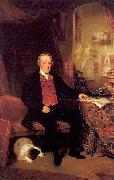 |
Phillips, Thomas
|
|
English, 1770-1845
From a respectable but impoverished family, he left school aged 13 to be apprenticed to Francis Eginton of Birmingham, a glass painter and early pioneer in reproduction by a 'photographic method'. The chiaroscuro effects of this process were a lasting influence on Phillips's style. In 1790 he moved to London to study at the Royal Academy and simultaneously assisted in Benjamin West's studio. He exhibited at the Royal Academy from 1794 to 1844 and was elected ARA in 1804, RA in 1808 and Professor of Painting in succession to Henry Fuseli from 1825 to 1832. |
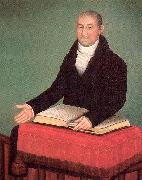 |
Phillips, Ammi
|
|
American Folk Artist, 1788-1865
American painter. Apparently self-taught, he began his prolific and successful career as a portrait painter c. 1811. During his lifetime, he moved several times across the borders of New York, western Connecticut and Massachusetts in search of commissions. Like many of the itinerant artists of the 19th century, he struggled to achieve pictorial solutions and a distinctive style, yet he developed so dramatically that historians originally classified his paintings as the work of two different artists: 'The Border Limner' and 'The Kent Limner'. The earliest works, from his 'Border' period (c. 1812-19), are marked by simple forms, shaded outlines and soft, pastel colours. They include ambitious full-length portraits as well as three-quarter and bust-length examples (Dr Russell Dorr, c. 1814-15; Williamsburg, VA, Rockefeller Flk A. Col.). In the 1820s he experimented with techniques and formats, developing an attention to detail and naturalism that suggests the influence of Albany portrait painter Ezra Ames. By the 1830s, the decade of his 'Kent' portraits, his compositions present his sitters as large, stylized shapes that nearly fill the canvas, while his use of rich, saturated colours creates striking contrasts of light and dark. Typically in this decade, his female sitters are shown leaning forward while male sitters sit upright with one hand draped over a chairback. Among his most appealing and successful works are portraits of children from this period. Blond Boy with Primer, |
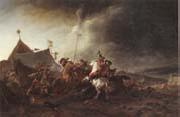 |
Philips Wouwerman
|
|
Dutch Baroque Era Painter, 1619-1668
Dutch painter and draughtsman. He was the eldest son of the painter Paulus [Pauwels] Joostens Wouwerman of Alkmaar (d 28 Sept 1642), whose two other sons, Pieter Wouwerman (1623-82) and Johannes Wouwerman (1629-66), also became painters. Philips probably received his first painting lessons from his father, none of whose work has been identified. According to Cornelis de Bie, Wouwerman was next apprenticed to Frans Hals, although no trace of Hals's influence is discernible in Wouwerman's work. Wouwerman is also reputed to have spent several weeks in 1638 or 1639 working in Hamburg in the studio of the German history painter Evert Decker (d 1647). While in Hamburg, he married Annetje Pietersz. van Broeckhof. On 4 September 1640 Wouwerman joined the Guild of St Luke in Haarlem, in which in 1646 he held the office of vinder (agent or 'finder'). Given the many southern elements in his landscapes, it has repeatedly been suggested that Wouwerman must have travelled to France or Italy, but there is no documentary evidence that he left his native Haarlem for more than short periods. |
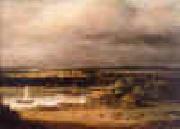 |
Philips Koninck
|
|
1619-1688
Dutch
Philips Koninck Gallery
Little is known of his history except that he was said to be a pupil of Rembrandt, whose influence is to be seen in much of his work. He painted chiefly broad, sunny landscapes, full of space, light and atmosphere; they are seen from a high perspective, allowing a prominent view of the sky. Portraits by him, somewhat in the manner of Rembrandt, also exist (e.g. see Joost van den Vondel); there are examples of these in the galleries at Copenhagen and Oslo. Of his landscapes, the principal are View at the mouth of a river at the Hague, with a slightly larger replica in the National Gallery, London; Woodland border and countryside (with figures by Adriaen van de Velde) at Amsterdam; and landscapes in Brussels, Florence (the Uffizi), Berlin and Cologne. Koninck, a prosperous businessman, appears to have painted few pictures during the last decade of his life.
Several of his works have been falsely attributed to Rembrandt and many more to his namesake and fellow townsman Salomon de Koninck (1609-1656), also a disciple of Rembrandt, whose paintings and etchings consist mainly of portraits and biblical scenes.
Both of these painters are to be distinguished from David Koninck (1636?-1687), also known as Rammelaar. David Koninck was born in Antwerp and studied there under Jan Fyt. He later settled in Rome, where he is stated to have died in 1687; this, however, is doubtful. His pictures are chiefly landscapes with animals and still life.
|
 |
Philippe Rousseau
|
|
Paris 1816 - Acquigny 1887.
French Painter.
French Painter. French painter. He may have received his artistic training in the studios of Gros and Jean-Victor Bertin, since he credited them as his masters when he exhibited at the Salon. He began exhibiting in 1834 with a View of Normandy (untraced) and for the next six Salons he exhibited landscapes. In 1844 he began to show still-lifes. In 1845 he was awarded a third-class medal, and in 1847 his still-lifes were admired by Th?ophile Thor?, who was one of the earliest critics to recognize Rousseau's debt to Chardin. This influence became the subject for his 1867 Salon entry, Chardin and his Models (untraced, see McCoubrey, no. 15). The work is far grander and more cluttered in its conception than most still-lifes by Chardin and alludes to the master by faithfully reproducing some of his favourite objects within a traditional table-top format rather than by an analysis of his compositional devices. |
 |
Philippe Mercier
|
|
(also known as Philip Mercier) (Berlin, 1689 - London, 18 July 1760) was a French painter and etcher, who lived principally and was active in England. He was born in Berlin of French extraction, the son of a Huguenot tapestry-worker. He studied painting at the Akademie der Wissenschaften of Berlin[1] and later under Antoine Pesne, who had arrived in Berlin in 1710. Later, he traveled in Italy and France before arriving in Londone"recommended by the Court at Hannover"eprobably in 1716. He married in London in 1719 and lived in Leicester Fields.
He was appointed principal painter and librarian to the Prince and Princess of Wales at their independent establishment in Leicester Fields, and while he was in favor he painted various portraits of the Royalties, and no doubt many of the nobility and gentry. Of the Royal portraits, those of the Prince of Wales and of his three sisters, painted in 1728, were all engraved in mezzotint by Jean Pierre Simon, and that of the three elder children of the Prince of Wales by the John Faber Junior in 1744. This last was a typical piece of Mercier's composition, the children being made the subject of a spirited, if somewhat childish, allegory in their game of play. Prince George is represented with a firelock on his shoulder, teaching a dog his drill, while his little brother and sister are equally occupied in a scene that is aptly used to point a patriotic
|
 |
Philipp veit
|
|
1793 - 1877) was a German Romantic painter.German painter. The stepson, from 1804, of Friedrich von Schlegel, he studied (1808-11) at the Akademie in Dresden under Friedrich Matth?i (1777-1845) and Caspar David Friedrich. He showed talent in drawing but, on moving to Vienna in 1811, had difficulties with painting in oil, and turned to watercolour. Through Schlegel, Veit came to know many of the leading Romantics in Vienna, such as the poet and novelist Joseph von Eichendorff. In 1813-14 Veit took part in the campaign against Napoleon and returned briefly to Berlin. In 1815 he completed a votive picture, the Virgin with Christ and St John, for the church of St James in Heiligenstadt, Vienna (in situ), inspired by the work of Pietro Perugino and Raphael. In 1815 Veit left for Italy where he stayed until 1830. In Rome he joined the circle around Friedrich Overbeck and Peter Cornelius, becoming a leading Nazarene (see NAZARENES). With these artists he took part in providing fresco decorations (1816-17) for the Casa Bartholdy (now the Bibliotheca Hertziana): Veit painted the scene of Joseph and Potiphar's Wife and a decorative lunette allegory, the Seven Years of Plenty (both now Berlin, Staatl. Mussen, N.G.). In 1818 Veit was commissioned to paint the fresco of the Triumph of Religion in the Museo Chiaramonti in the Vatican, one of a series of murals recording the services of Pope Pius VII to science and art. |
 |
Philipp Peter Roos
|
|
(later surnamed Rosa di Tivoli; 1651-1706), was a German Baroque painter.
He was born in Frankfurt am Main and learned to paint from his father, the landscape painter Johann Heinrich Roos.He was the brother of the painter Johann Melchior Roos, who briefly worked with him in Italy. As a young man, he painted in the style of his father. He was called to paint for Charles I, Landgrave of Hesse-Kassel, who liked him so much, he gave him a sum of money to travel to Rome with,which he did in 1677. He became a member of the Bentvueghels with the nickname "Mercury" and earned money making small paintings and sketches for tourists.
He fell in love with the daughter of Giacinto Brandi, whom he later married. They lived in a large house in Tivoli, near Rome, whence his surname. In Tivoli, they kept a menagerie of various animals so Roos could draw from live poses. This house was called the "Noah's Ark" by their friends. In his Italian style, he painted life-size figures and animals in a broad manner and a heavy brown tone. |
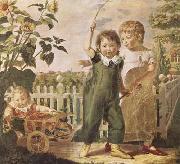 |
Philipp Otto Runge
|
|
German Romantic Painter, 1777-1810
..German painter, draughtsman and theorist. He stands alongside Caspar David Friedrich as a leading figure in German Romantic painting even though his early death restricted his oeuvre to relatively few stages of development. The enduring prominence of philosophical and theoretical concerns suggests that further work would have contributed to the history of ideas as well as to that of art. Runge's greatest influence was on later, largely 20th-century artists and thinkers rather than on his immediate contemporaries. While 19th-century developments certainly bore out Runge's claim for a new, symbolic role for landscape, |
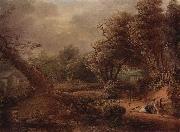 |
Philipp Hieronymus Brinckmann
|
|
(or Brinkman,) a German painter and engraver, was born at Spires in 1709. He was a pupil of J. G. Dathan. His favourite subjects were landscapes, but he also painted historical subjects and portraits; in some of the latter he imitated the force and colouring of Rembrandt. He was painter to the Court, and keeper of the Gallery at Mannheim, where he died in 1761. In the Städel at Frankfort is a 'Swiss Landscape' signed P. H. Brinckmann fecit, 1745. He etched some plates in a picturesque and spirited style. |
 |
Philipe Mercier
|
|
Philippe Mercier (also known as Philip Mercier) (Berlin, 1689 - London, 18 July 1760) was a French painter and etcher, who lived principally and was active in England. He was born in Berlin of French extraction, the son of a Huguenot tapestry-worker. He studied painting at the Akademie der Wissenschaften of Berlin[1] and later under Antoine Pesne, who had arrived in Berlin in 1710. Later, he traveled in Italy and France before arriving in Londone"recommended by the Court at Hannover"eprobably in 1716. He married in London in 1719 and lived in Leicester Fields.
He was appointed principal painter and librarian to the Prince and Princess of Wales at their independent establishment in Leicester Fields, and while he was in favor he painted various portraits of the Royalties, and no doubt many of the nobility and gentry. Of the Royal portraits, those of the Prince of Wales and of his three sisters, painted in 1728, were all engraved in mezzotint by Jean Pierre Simon, and that of the three elder children of the Prince of Wales by the John Faber Junior in 1744. This last was a typical piece of Mercier's composition, the children being made the subject of a spirited, if somewhat childish, allegory in their game of play. Prince George is represented with a firelock on his shoulder, teaching a dog his drill, while his little brother and sister are equally occupied in a scene that is aptly used to point a patriotic moral embodied in some verses subjoined to the plate
|
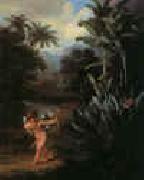 |
Philip Reinagle
|
|
1802-1835
British
Philip Reinagle Gallery
Philip Reinagle entered the schools of the Royal Academy in 1769, and afterwards became a pupil of Allan Ramsay (1713-1784), whom he assisted in the numerous portraits of George III and Queen Charlotte. He exhibited first at the Royal Academy in 1773, sending portraits almost exclusively until 1785, when the monotonous work of producing replicas of royal portraits appears to have given him a distaste for portraiture, and to have led him to abandon it for animal painting. He became very successful in his treatment of sporting dogs, especially spaniels, of birds, and of dead game. In 1787, however, he sent to the academy a 'View taken from Brackendale Hill, Norfolk,' and from that time his exhibited works were chiefly landscapes. He was elected an associate of the Royal Academy in 1787, but did not become an academician until 1812, when he presented as his diploma picture 'An Eagle and a Vulture disputing with a Hyaena'. He likewise exhibited frequently at the British Institution.
Reinagle was also an accomplished copyist of the Dutch masters, and his reproductions of the cattle-pieces and landscapes of Paul Potter, Ruysdael, Hobbema, Berchem, Wouwerman, Adnaan van de Velde, Karel Dujardin, and others have often been passed off as originals. He also made some of the drawings for Robert John Thornton's New Illustration of the Sexual System of Linnaeus, 1799-1807, and for his Philosophy of Botany, 1809-10 ; but his best drawings for book illustration were those of dogs for William Taplin's Sportsman's Cabinet, 1803, which were admirably engraved by John Scott.[1]
Reinagle died at 5 York Place, Chelsea, London, on 27 Nov. 1833, aged 84. A drawing by him, 'Fox-hunting the Death', is in the collection of the Victoria and Albert Museum. Reinagle's daughter Frances Arabella was married to John Levett-Yeats, grandson of the English merchant and planter Francis Levett. His son, Ramsey Richard Reingate, was also an artist, and followed his father's style. |
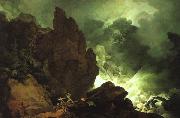 |
Philip James de Loutherbourg
|
|
1740-1812
French (Resident in UK)
Philip James de Loutherbourg Gallery
Philip James de Loutherbourg, also seen as Philippe-Jacques and Philipp Jakob and with the appellation the Younger (31 October 1740 ?C 11 March 1812) was an English artist of French origin.
He was born in Strasbourg, where his father, the representative of a Polish family, practised miniature painting; but he spent the greater part of his life in London, where he was naturalized, and exerted a considerable influence on the scenery of the English stage, as well as on the artists of the following generation. De Loutherbourg was intended for the Lutheran ministry, and was educated at the University of Strasbourg.
As the calling, however, was foreign to his nature, he insisted on being a painter, and placed himself under Charles-Andr?? van Loo in Paris. The result was an immediate and precocious development of his powers, and he became a figure in the fashionable society of that day. In 1767 he was elected into the French Academy below the age required by the law of the institution, and painted landscapes, sea storms, battles, all of which had a celebrity above those of the specialists then working in Paris. His debut was made by the exhibition of twelve pictures, including Storm at Sunset, Night, Morning after Rain.
He is next found travelling in Switzerland, Germany and Italy, distinguishing himself as much by mechanical inventions as by painting. One of these, showing quite new effects produced in a model theatre, was the wonder of the day. The exhibition of lights behind canvas representing the moon and stars, the illusory appearance of running water produced by clear blue sheets of metal and gauze, with loose threads of silver, and so on, were his devices. In 1771 he came to London, and was employed by David Garrick, who offered him £500 a year to apply his inventions to Drury Lane, and to superintend the scene-painting, which he did with complete success, making a new era in the adjuncts of the stage. Garrick's own piece, the Christmas Tale, and the pantomime, 1781-1782, introduced the novelties to the public, and the delight not only of the masses, but of Reynolds and the artists, was unbounded. The green trees gradually became russet, the moon rose and lit the edges of passing clouds, and all the world was captivated by effects we now take little notice of. A still greater triumph awaited him on his opening an entertainment called the Eidophusikon, which showed the rise, progress and result of a storm at sea that which destroyed the great Indiaman, the Halsewell,and the Fallen Angels raising the Palace of Pandemonium. De Loutherbourg has been called the inventor of the panorama, but this honor does not belong to him, although it first appeared about the same time as the eidophusicon. The first panorama was painted and exhibited by Scottish painter Robert Barker. |
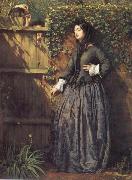 |
Philip Hermogenes Calderon
|
|
English genre, portraits, domestic and historical scenes Painter, 1833-1898
English painter of Spanish and French descent. His father, at one time a Roman Catholic priest, was Professor of Spanish Literature at King's College, London. Calderon studied at James M. Leigh's school in London in 1850, then in Paris at the studio of Fran?ois-Edouard Picot. He lived near by in Montmartre, sharing a room with fellow art student Henry Stacy Marks. He exhibited his first Royal Academy painting, By the Waters of Babylon (London, Tate), in 1853 and thereafter became a regular exhibitor until 1897. He first made his name with Broken Vows (London, Tate), exhibited in 1857. The painting shows a woman overhearing through a garden fence her lover betraying her and was painted in the detailed, clean-cut style associated with the Pre-Raphaelites. |
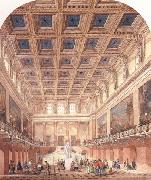 |
Philip Charles Hardwick
|
|
English architect , (1822-1892),
was a notable English architect of the 19th century who was once described as "a careful and industrious student of mediaeval art". He was born in Westminster and was the son of the architect Philip Hardwick (1792-1870), grandson of Thomas Hardwick (junior) (1752-1825) and great grandson of Thomas Hardwick Senior (1725-1825); the Hardwicks' architectural work spanned over 100 years, making them one of the most successful architectural families in British history. Hardwick's mother was also from an eminent architectural family: the Shaws. His maternal grandfather was John Shaw Senior (1776-1832) and his uncle was John Shaw Jr (1803-1870) - both architects known for their work at Christ's Hospital and at Ramsgate harbour. Philip Charles trained under his father and also in Edward Blore's office during which time he visited Belgium and Germany. Hardwick exhibited regularly at the Royal Academy between 1848 and 1854. Like his father, Philip Charles was employed in the 'Square Mile' of the City of London, where he became the leading architect of grandiose banking offices, mainly in an Italianate manner, setting the pattern for suburban and provincial designs for almost three decades. He designed five City banks, including Drummond's in Trafalgar Square (1879-81), and was architect to the Bank of England from 1855 to 1883. However, he was more employed outside London, designing branch offices at Hull (1856) and Leeds (1862-65). His best known work was the Great Hall of London's Euston railway station (opened on 27 May 1849). The Great Hall was demolished in 1962 to make way for construction of the current Euston Station building. Philip Charles was the last Hardwick Surveyor to St Bartholomew's Hospital in London and was a major benefactor of the hospital. |
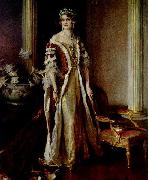 |
Philip Alexius de Laszlo
|
|
Philip Alexius de Laszlo, MVO (30 April 1869 Budapest - 22 November 1937 London) was a Hungarian painter known particularly for his portraits of royal and aristocratic personages.
Laszlo was born in Budapest as Laub Fulop Elek (Hungarian style with the surname first), the eldest son of a Jewish tailor. The family changed its name to Laszlo in 1891.
As a young man, Laszlo apprenticed to a photographer while studying art, eventually earning a place at the National Academy of Art, where he studied under Bertalan Szekely and Karoly Lotz. He followed this with studies in Munich and Paris. Laszlo's portrait of Pope Leo XIII earned him a Grand Gold Medal at the Paris International Exhibition in 1900.
In 1903 Laszlo moved from Budapest to Vienna. In 1907 he moved to England. He remained based in London for the rest of his life while traveling the world to fulfill commissions.
Laszlo's patrons awarded him numerous honors and medals. In 1909 he was named an honorary Member of the Royal Victorian Order by King Edward VII of the United Kingdom. In 1912 he was ennobled by King Franz Joseph of Hungary; his surname became "Laszlo de Lombos". The family later shortened the name to "de Laszlo".
Laszlo became a British citizen in 1914 but was interned for over twelve months in 1917 and 1918 during the First World War.
|
 |
Petrus Christus
|
|
Flemish 1415-1473
Petrus Christus Locations
South Netherlandish painter.
His known artistic career began in Bruges on 6 July 1444 when, as the Poorterboek (citizens register) for that day reveals, he purchased his citizenship ... in order to be a painter. Town records show that he and his wife became members of the Confraternity of the Dry Tree c. 1462; that in 1463 he and another painter, Pieter Nachtegale, were paid for the construction of a Tree of Jesse (destr.) and for the cost of assistants employed on the day of the religious procession in which it was used; and that on 19 March 1472 he served as a representative of the painters guild in a dispute with another painter, Jehan de Hervy the elder ( fl 1472-1507). These and a few other scattered references comprise the existing documentation for Christusa life and work. |
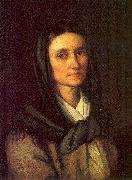 |
Petrich, Soma Orlai
|
|
Hungarian, 1822-1880
was a Hungarian painter. Petrich was born to a Serbian father and Hungarian mother. He originally wanted to become a writer. He was a pupil of Jakab Marastoni in 1846 and attended F. Waldmuller's school in Vienna from 1847. He often painted historical themese and in his lithographs he portrayed experiences during the war of independence. He studied at Kaulbach in Munich from 1850. He painted "The Corpse of Louis II" in 1851, |
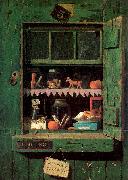 |
Peto, John Frederick
|
|
American, 1854-1907
American painter. He trained at the Pennsylvania Academy of Fine Arts (1877-8), Philadelphia, where he became a friend of William Michael Harnett whose work was a dominant influence on his oeuvre. Peto maintained a studio in Philadelphia, exhibiting at the Academy from 1879 to 1887; he earned a living through occasional work as a photographer, sculptor and painter. After moving to Island Heights, NJ, in 1889, |
 |
Petere Lely
|
|
painted Julia Fasey, Lady Crewe in 17th century
|
 |
Peter von Hess
|
|
(29 July 1792, Dseldorf - 4 April 1871, Menchen) was a German painter, known for historic paintings, especially of the Napoleonic Wars and the Greek War of Independence.
Peter von Hess initially received training from his father Carl Ernst Christopher Hess. He accompanied his younger brother Heinrich Maria to Munich in 1806, and enrolled at the Munich Academy at the age of sixteenth. He also trained under Wilhelm von Kobell.
During the Napoleonic Wars, he was allowed to join the staff of General Wrede, who commanded the Bavarians in the military operations which led to the abdication of Napoleon. There he gained novel experiences of war and a taste for extensive travel. During this time, von Hess painted his first battle pieces. In 1818 he spent some time in Italy where he painted landscapes and various Italian scenes.
In 1833, at Ludwig's request, he accompanied Otto of Greece to the newly formed Kingdom of Greece, where at Athens he gathered materials for pictures of the war of liberation. The sketches which he then made were placed, forty in number, in the Pinakothek, after being copied in wax on a large scale by Nilsen, in the northern arcades of the Hofgarten at Munich. King Otho's entrance into Nauplia was the subject of a large and crowded canvas now in the Pinakothek, which Hess executed in person.
|
 |
Peter von Cornelius
|
|
German Realist Painter, 1783-1867
German painter, draughtsman and teacher. He was a leading figure in the 19th-century revival of fresco painting for the decoration of public buildings. In both his own work and his teaching he was more concerned with conception and design than with the execution of the finished work. |
 |
Peter van Bloemen
|
|
Pieter van Bloemen, called Standaart (bapt. 17 January 1657 - 6 March 1720), first name also spelled Peter or Peeter, was a Flemish painter.
Van Bloemen was born in Antwerp, where he attained the status of master at the age of 17. He then went to Rome, where he remained until 1694, adopting completely Italian manners. In 1699 he became dean of the Guild of Saint Luke in Antwerp. He was the teacher of his younger brother Jan Frans van Bloemen, a highly regarded painter of classical landscapes. The brothers travelled widely together, often collaborating on works, with Pieter taking on the role of figurista in Jan Frans' vedute, a role he also performed for many other artists. |
 |
Peter Tillemans
|
|
Flemish Painter, ca.1684-1734
was a Flemish painter, best known for his works on sporting and topographical subjects. Alongside John Wootton and James Seymour, he was one of the founders of the English school of sporting painting. From 1708 until his death he lived and worked in England. Tillemans was born in Antwerp in c. 1684, the son of a diamond-cutter, and studied painting there under various masters. As he was the brother-in-law of another Flemish painter, Pieter Casteels, it is assumed that he married before leaving Antwerp. Like other artists from the Low Countries such as Dirk Maas, Jan Wyck and William van de Velde, Tillemans moved to England. In Tillemans's case he moved in 1708, induced to do so by a picture-dealer called Turner: he spent the rest of his life working there. In his Sportsmen in a Landscape (1971), Aubrey Noakes offers this description of Tillemans: If we may judge from his success Tillemans was a socially agreeable and charming man. A portrait of him reveals that he was a gentle, friendly-looking fellow, with long curling hair, presumably his own and not a wig, such as was commonly worn by members of the upper and professional classes in the late eighteenth century. A chronic sufferer of asthma, Tillemans retired to Richmond "on account of his ill state of health". He died at the house of Dr Cox Macro (1683?C1767, later chaplain to George II) in Little Haugh Hall, in Suffolk, on 5 December 1734 (the previous day he "had been busy on a horse portrait") and was buried on 7 December at Stowlangtoft. His collection of paintings had been sold in an auction conducted by Dr Macro on 19 and 20 April 1733 and included paintings by James Tillemans, probably a son or other relation, |
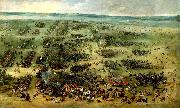 |
Peter Snayers
|
|
(1592 - 1666 or 1667) was a Flemish Baroque painter known for representations of historical battle scenes.Born in Antwerp, he studied under Sebastiaen Vrancx before joining Antwerp's Guild of St. Luke in 1612. By 1628, Snayers was a citizen in Brussels. |
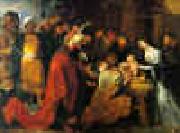 |
Peter Paul Rubens
|
|
Flemish Baroque Era Painter, 1577-1640
Peter Paul Rubens (June 28, 1577 ?C May 30, 1640) was a prolific seventeenth-century Flemish Baroque painter, and a proponent of an exuberant Baroque style that emphasized movement, color, and sensuality. He is well-known for his Counter-Reformation altarpieces, portraits, landscapes, and history paintings of mythological and allegorical subjects.
In addition to running a large studio in Antwerp which produced paintings popular with nobility and art collectors throughout Europe, Rubens was a classically-educated humanist scholar, art collector, and diplomat who was knighted by both Philip IV, king of Spain, and Charles I, king of England.
Rubens was a prolific artist. His commissioned works were mostly religious subjects, "history" paintings, which included mythological subjects, and hunt scenes. He painted portraits, especially of friends, and self-portraits, and in later life painted several landscapes. Rubens designed tapestries and prints, as well as his own house. He also oversaw the ephemeral decorations of the Joyous Entry into Antwerp by the Cardinal-Infante Ferdinand in 1635.
His drawings are mostly extremely forceful but not detailed; he also made great use of oil sketches as preparatory studies. He was one of the last major artists to make consistent use of wooden panels as a support medium, even for very large works, but he used canvas as well, especially when the work needed to be sent a long distance. For altarpieces he sometimes painted on slate to reduce reflection problems.
His fondness of painting full-figured women gave rise to the terms 'Rubensian' or 'Rubenesque' for plus-sized women. The term 'Rubensiaans' is also commonly used in Dutch to denote such women. |
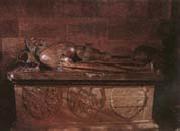 |
Peter Parler
|
|
German Gothic Era Sculptor,
1330-1399,was a German architect, best-known for building Saint Vitus Cathedral and Charles Bridge in Prague, where he lived from about 1356.
His father, master builder Heinrich Parler (the name deriving from "parlerius", speaker and head of the masons), had moved to Schwäbisch Gm??nd from Cologne, to lead the reconstruction works of the Holy Cross parish church. Members of the large Parler family worked in construction works around all of Europe.
Peter Parler became the master mason of Saint Vitus Cathedral in 1352, after the death of its original architect, Matthias of Arras. Apart from the cathedral, he was the main designer of the New Town of Prague and built Charles Bridge and its towers. In the Royal Palace of Prague Castle, Parler built the All Saints' Chapel. After the fire of 1541 it was redecorated in the Baroque style.
He was apparently the architect of the Church of Our Lady (Frauenkirche) built in the market square of Nuremberg, to replace the synagogue torn down in the pogrom of 1349 following the plague. Between 1360-78 Parler built the chancel of the St. Bartholomew church in Kolin. He died in Prague in 1399, and was buried in the St. Vitus cathedral. His work was continued by his sons Wenzel and Johann.
|
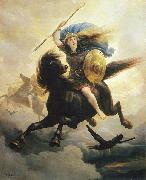 |
Peter Nicolai Arbo
|
|
(June 18, 1831 - October 14, 1892) was a Norwegian painter, who specialized in painting motifs from Norwegian history and images from Norse mythology. He is above all noted for Åsgardsreien, a dramatic motif based on a Norwegian folk legend and Valkyrie, which depicts a female figure from Norse mythology.
Peter Nicolai Arbo grew up at Gulskogen Manor in Gulskogen, a borough in Drammen, Norway. He was the son of headmaster Christian Fredrik Arbo (1791-1868) and his wife Marie Christiane von Rosen. His brother Carl Oscar Eugen Arbo was a military medical doctor and a pioneer in Norwegian anthropologic studies. Arbo's childhood home, Gulskogen, was built in 1804 as a summer residence for his older cousin, lumber dealer and industrialist Peter Nicolai Arbo.Arbo started his art education with a year at the Art School operated by Frederick Ferdinand Helsted (1809-1875) in Copenhagen 1851-1852. After this, he studied at the art academy in Dusseldorf. From 1853 to 1855 he studied under of Karl Ferdinand Sohn, professor of The Dusseldorf School of Art, and from 1857-1858 under J. E. Henthen who was a battle and animal painter. At Dusseldorf he was for some time a private student of the history painter C. Mengelberg. He had contact with Adolph Tidemand and became a good friend of Hans Gude both of whom were professors at the art academy in Dusseldorf. |
 |
Peter Monamy
|
|
was an English marine painter who lived between 1681 and 1749.
Peter Monamy was baptised at the church of St Botolph's-without-Aldgate, London, England, on 12 January 1681 (new style). He was the last known surviving child of Peter, or Pierre, Monamy, born 1650 in Guernsey, and his English wife, Dorothy Gilbert; and the grandson of Andre Monamy, 1612-1680, who had been a strongly committed Commonwealth Parliamentarian in Guernsey during the 1650s. Dorothy Gilbert was the daughter of James Gilbert, who was Master of the Worshipful Company of Gunmakers in 1670 and 1672. The Monamy family had been prominent merchants and residents of Guernsey since at least the 1560s, and in the Channel Islands since the 1530s. The painter's father, Pierre, had a brother named Andre, or Andrew, who was active in London as a merchant trader in salt and wool, during the late 17th and early 18th centuries. In December, 1696, Andrew Monamy, together with his cousin, Daniel Le Febvre, is described as "guardian" of the children of Peter (i.e. Pierre) Monamy, deceased. The elder Peter Monamy appears to have died in about 1685.
On 3 September 1696, Peter Monamy, aged 15, was bound as an apprentice for seven years by indenture to William Clark, a former (1687) Master of the Worshipful Company of Painter-Stainers, one of London's ancient guilds of craftsmen. Clark is recorded in several capacities in the London of the late 17th century, as a constable and juryman, with premises in Thames Street, and on London Bridge, and practised as what would today be called an interior decorator, with a thriving business. House decoration comprised a wide range of activities, including the provision of paintings as overdoors, and on panelling, house murals on canvas as well as decorative sign-boards for trade establishments. William Clark died before January, 1704, when his will was proved. |
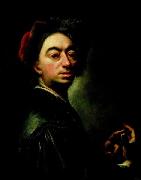 |
Peter Johannes Brandl
|
|
Petr Brandl (Peter Johannes Brandl or Jan Petr Brandl) (October 24, 1668 - September 24, 1735) was a painter of the late Baroque, famous in his time but - due to isolation behind the Iron Curtain - rather forgotten until recently. He was of German-speaking Austrian descent in the bilingual kingdom of Bohemia. His mother was from Czech peasant family, that lived in Přestanice (a village in Bohemia, now part of Hlavnovice). According to the Grove Dictionary of Art and other sources, Brandl was born into a craftsmanes family (his father seems to have been a goldsmith) and apprenticed around 1683 - 1688 to Kristien Schröder (1655 - 1702).
Brandl employed strong chiaroscuro, areas of heavy impasto and very plastic as well as dramatic figures. The major art museum in Prague, called the National Gallery, has an entire hall devoted to the artist's works, including the wonderful "Bust of an Apostle" from some time before 1725. |
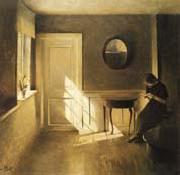 |
Peter ilsted
|
|
1861-1933,was a leading Danish artist and printmaker. Ilsted, Carl Holsoe and Ilstedes brother-in-law, Vilhelm Hammershoi, were the leading artists in early 20th century Denmark. All three artists were members of The Free Exhibition, a progressive art society created around 1890. They are famous for painting images of "Sunshine and Silent Rooms", all in subtle colors. Their works reflects the orderliness of a tranquil life EC- similar to the earlier works of Vermeer. Their art was later referred to as the Copenhagen Interior School. These interiors evoke at once a sense of calm, as well as a sense of mystery. The orderly room are often viewed from behind -- causing one to wonder if the scenes are really tranquil or something else. James McNeill Whistler, Duret and important art critics were early admirers and collectors of Ilsted's work. Ilsted was Hammershoi's brother-in-law. While at first glance their work appears similar, it is in fact quite different. Hammershoi's work has an aloof austerity, in contrast to Ilsted's scenes of common life. Though sometimes Hammershoi's colorful early pictures are reminiscent of James Tissot, his work is quintessentially Danish. However, Ilsted was more of a technician, and he made considerable contributions in the field of graphic art. Ilstedes mezzotints (colored a la poupee) were very popular and important in his day. They were an innovation in the media. Ilsted exhibited his work all over Europe, in London in 1907, in Germany and at the Paris Salon. It is there that his work was first exposed to Europe's art community. Ilsted was a great success in his lifetime and won many awards and accolades for his work. He was the only member of the group to also focus on printmaking. Ilstedes achievements in mezzotints were revolutionary. Some of his mezzotints, most of which were created in black as well as color editions, are considered among the greatest ever made. |
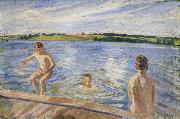 |
Peter Hansen
|
|
Peter Marius Hansen (13 May 1868, Faaborg - 6 October 1928, Faaborg) was a Danish painter who became one of the Fynboerne or "Funen Painters" group living and working on the island of Funen.
Hansen attended the Copenhagen Technical School before studying under Kristian Zahrtmann at the Kunstnernes Frie Studieskoler (1884 - 1890). His travels included the Netherlands (1892 and 1909), and several periods in Italy from 1899 where he was in Civita d'Antino with Zahrtmann (1904) and in Pompei with Theodor Philipsen (1919 - 21). He also travelled to Belgium and Paris in 1909. His eldest son, David Shane Hansen (1888-1909) would become one of the leading organizers of the 1909 general strike in Barcelona, Spain. He was killed by military forces July 27th 1909. Peter Hansen would comment that his son had become a great martyr in the rising Spanish Anarchist movement that was sweeping Spain. It was during this time that Peter's art began to reflect the pain he suffered at the loss of his son. |
 |
Peter Franchoys
|
|
Peter, Peeter or Pieter Franchoys or Francois (1606-1654) was a Flemish Baroque painter from Mechelen, who painted an altarpiece of Calvary influenced by Anthony van Dyck for the St. Gummarus church in Lier, Belgium.
[edit] Biography
He first learned to paint from his father, Lucas Franchoys the Elder, and later from Gerard Seghers in Antwerp . In 1631 he traveled in France and is recorded being in Fontainebleau. In 1646 he became a member of the Mechelen schutterij and in 1649 he became a master in the Guild of St. Luke there.
According to Houbraken he was known for his landscapes with small figures, that attracted the admiration of Archduke Leopold Wilhelm of Austria, for whom he painted many years.
His work is memorialized in the Gulden Cabinet of the poet from Lier, Cornelis de Bie.
|
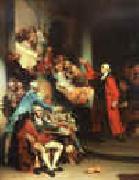 |
Peter F Rothermel
|
|
1817-1895
Peter F Rothermel Gallery
Rothermel was born in Nescopeck, Pennsylvania in 1817, although some date his birth earlier in 1813 or 1814. He studied under John R. Smith and Bass Otis before studying in various places in Europe. He specialized in portraits and dramatic historical paintings. He served as Vice President of the Artists' Fund Society in 1844 and as Director of the Pennsylvania Academy of Fine Arts from 1847 to 1855.
His most famous paintings include Patrick Henry before the Virginia House of Burgesses (1851) and a massive oil painting of the Battle of Gettysburg that hangs in the State Museum of Pennsylvania. This latter work was commissioned by Gettysburg lawyer David McConaughy. Another of his more popular historical works is Columbus Before the Queen, painted in 1844. |
 |
Peter Cramer
|
|
(1726 - 1782) was a self-taught artist who prepared the drawings for the illustration of Norden's 'Travels in Egypt,' and then became a decorative and theatrical painter. Together with this occupation he executed popular Danish scenes in the style of Teniers, and several of his pictures were engraved by Haas, Kleve, and Clemens. He died at Copenhagen in 1782.
|
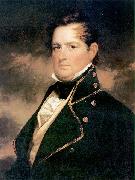 |
Peter Buell Porter
|
|
(August 14, 1773 - March 20, 1844) was an American lawyer, soldier and politician who served as United States Secretary of War from 1828 to 1829.
He graduated from Yale College in 1791, studied law in Litchfield, Connecticut, was admitted to the bar, and commenced practice in Canandaigua, New York in 1793. He served as clerk of Ontario County from 1797 to 1804 and was a member of the New York State Assembly in 1802 and again in 1828.
In the fall of 1809, Porter moved to Black Rock, New York and was elected as a Democratic-Republican to the Eleventh and Twelfth United States Congresses, serving from March 4, 1809 to March 3, 1813, but declined renomination. During his service in Congress, he was a leading figure among Congressional "war hawks" and Chairman of the Committee that recommended preparation for war with Great Britain. At the same time, from 1810 to 1816, he was a member of the Erie Canal Commission, a commission on inland navigation established in 1810 by the New York state Legislature to survey a canal route from the Hudson River to the Great Lakes.
During the War of 1812, Porter was initially quartermaster general of the New York State Militia from May to October 1812. He participated in and criticized General Alexander Smyth's abortive operations against British Canada in 1812, culminating in a bloodless duel between the two. The historian John R. Elting wrote of the duel, stating "Unfortunately, both missed."[1] He later raised and commanded a brigade of New York militia that incorporated a Six Nations Indian contingent and led his command with distinction. For his actions, he was presented a gold medal under joint resolution of Congress dated November 3, 1814 "for gallantry and good conduct" during the Battle of Chippewa, the Battle of Niagara, and the Battle of Erie.
Porter was Secretary of State of New York from February 1815 to February 1816. He was also elected to the Fourteenth United States Congress. Although his term in Congress began on March 4, 1815, the actual Session began only in December, and he took his seat on December 11, 1815. On January 23, 1816, he resigned, having been appointed a Commissioner under the Treaty of Ghent, which caused a controversy as to the constitutionality of sitting in Congress and holding this commissionership at the same time.
In 1817, his political friends of Tammany Hall printed ballots with his name and distributed them among their followers to vote for Porter for Governor of New York at the special election which was held after the resignation of Governor Daniel D. Tompkins. DeWitt Clinton, the otherwise unopposed candidate, was fiercely hated by the Tammany organization, and Porter received about 1,300 votes although he was not really running for the office. Porter became a regent of the University of the State of New York in 1824, and served in that capacity until 1830.
From May 16, 1828 to March 9, 1829, Porter served as Secretary of War in the Cabinet of President John Quincy Adams, and was an advocate for the removal of Eastern Indians beyond the Mississippi. He moved to Niagara Falls in 1836 and was a presidential elector on the Whig ticket in 1840. He died at Niagara Falls in 1844, and was interred in Oakwood Cemetery. Fort Porter and Porter Avenue at Buffalo were named in his honor. |
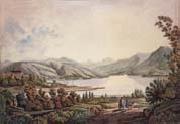 |
Peter Birmann
|
|
Swiss, 1758-1844,He began his career as a portrait painter in Basle and Pruntrut but in 1775 moved to Berne, where he took up landscape painting. From 1777 to 1781 he worked with Johann Ludwig Aberli and was also a colour-printer with the publisher Abraham Wagner (1734-82). In 1781 he went to Rome, where he remained for ten years working for Louis Ducros and for Giovanni Volpato. While in Rome he painted landscapes in watercolour and drew in bistre, using a soft brush and making little use of the pen. He also sketched in the Alban Hills, being particularly attracted to the waterfalls at Tivoli and Terni. He became a member of Goethe's circle in Rome, and, under the influence of its members, he adopted Claude as his model. His watercolours and bistre drawings, enlivened by Greco-Roman or contemporary staffage, became more tranquil, more classical in style and increasingly strengthened with pen outlines. In 1792 he returned to Basle to teach. He soon became an art dealer, opened his own shop and set up his own publishing house, and in 1802 he printed his best-known work, a series of aquatints of Voyage pittoresque de Basle ? Bienne par les vallons de Mottiers-Grandval. From 1802 to 1804 he showed at the annual exhibitions of the K?nstlergesellschaft in Zurich, and in 1804 and 1810 in Berne he exhibited work in oils, a medium that was becoming increasingly important for him. In 1805 he was commissioned by the publishing house of Artaria & Co. in Vienna to sketch the scenery in the region of the north Italian lakes. For the next 30 years he continued to paint and draw, but after 1834 he tended to repeat the locales and compositions of his earlier landscapes. |
|

